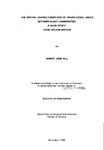THE SPATIAL CHARACTERISATION OF TRANSITIONAL AREAS BETWEEN PLANT COMMUNITIES: A CASE STUDY FROM UPLAND BRITAIN
| dc.contributor.author | GILL, WENDY JANE | |
| dc.contributor.other | School of Geography, Earth and Environmental Sciences | en_US |
| dc.date.accessioned | 2013-10-14T09:32:12Z | |
| dc.date.available | 2013-10-14T09:32:12Z | |
| dc.date.issued | 1996 | |
| dc.identifier | NOT AVAILABLE | en_US |
| dc.identifier.uri | http://hdl.handle.net/10026.1/2196 | |
| dc.description.abstract |
The concept of the ecotone was formalised by Clements (1 905) as a boundary zone between plant communities. Little research exists on the ecological importance or the geographical variability of these zones. Two types of boundaries are acknowledged: the ecotone and the ecocline. The ecotone is a sharp boundary; the ecocline a gradual boundary. The term 'transitional area' is proposed here to more accurately describe these areas as this research demonstrates that a complex continuum exists between the two end points. Additionally, mosaics often complicate the nature of the transition and may form a boundary type in their own right. Upland plant communities represent important semi-natural habitats within the British Isles. Effective management depends on an understanding of their structure and function. This research is primarily concerned with the description of structure (spatial pattern and variability in floristic composition) but explanation of these patterns is only possible through an understanding of function (vegetation dynamics). Pilot studies determined an appropriate methodology for studying transitional areas. The approach progressed from a linear transect to a two-dimensional rectangular transect. The pilot studies also evaluated a range of methods for data analysis. Extended field sampling followed which included 23 sites in 4 locations: Dartmoor, Snowdonia, North York Moors and Barra, Western Isles of Scotland. Data analysis exposed the complexities of the transitional areas sampled but 'noise' often obscured the true characteristics. To overcome this a Species Ratio Index Model was devised to identify the strength of signal for each boundary. The final characterisation of transitional areas is based on three main components: ecotone, ecocline and mosaics, each displaying varying amplitude. Of the sites sampled, few boundaries revealed single characteristics and the majority were far more complex than their observed patterns implied. On the basis of this characterisation a classification is proposed which incorporates both natural and anthropogenic factors. The classification represents an important contribution to the understanding of boundary types. This study reinforces the significance of boundaries in the landscape. The potential for future research is great, particularly through the development of a predictive model for management purposes. | en_US |
| dc.language.iso | en | en_US |
| dc.publisher | University of Plymouth | en_US |
| dc.title | THE SPATIAL CHARACTERISATION OF TRANSITIONAL AREAS BETWEEN PLANT COMMUNITIES: A CASE STUDY FROM UPLAND BRITAIN | en_US |
| dc.type | Thesis | |
| dc.identifier.doi | http://dx.doi.org/10.24382/3277 | |
| dc.identifier.doi | http://dx.doi.org/10.24382/3277 |
Files in this item
This item appears in the following Collection(s)
-
01 Research Theses Main Collection
Research Theses Main


